Freem Page || Vector Page || Developer’s Site
Unblade is an over-the-top action platformer starring a frog wielding an umbrella blade and it’s as amazing as it sounds. Your rather unconventional weapon with its various quirks is the main draw, though varied, well-crafted levels, secret collectibles, and awesome action sequences all definitely contribute to making Unblade worth playing.
Weird weapons usually lead to creative gameplay mechanics and your unblade is no exception. You can’t attack downward, but you can stab to the sides and directly up to attack enemies and break boxes like with a typical melee weapon. More importantly, holding down the attack button will call the unblade to open into its full umbrella form. While in this form the unblade can no longer cause damage and it instead becomes a utility tool. When the opened unblade is directly above you it allows you to slow your descent so you can cover large horizontal distances and move with precision. From the side, you can use the unblade in its umbrella form to safely detonate landmines or to block projectiles and explosions (vertically-aligned attacks need to be blocked from above).
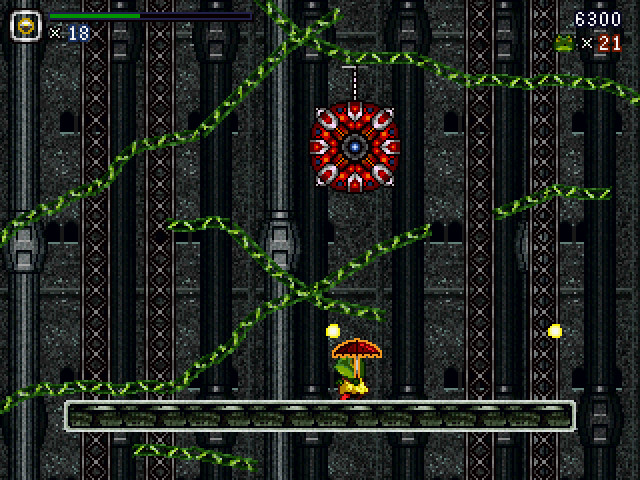
The unblade is, for the most part, a great weapon which gets used in all sorts of creative ways which we’ll be taking a look at soon enough, but it’s not perfect. Specifically, the bounce mechanic is imprecise and rarely works in your favor. Since the unblade doesn’t damage enemies while opened, it lets you bounce off of them on contact instead. You don’t move very far when bounced so you generally end up performing a series of rapid, small bounces. Ideally, this gives you an added layer of mobility via flying enemies and spiked platforms, especially since the umbrella reaches below you feet on the sides.
Realistically, this results in the unblade getting caught on enemies, forcing you to choose between being dragged along or putting the unblade away and hoping you don’t land in a pit. For example, if you’re gliding across a gap the protagonist, Inui, may not touch an enemy with his hitbox, but the umbrella above his head might glance it, immediately pulling you upward or shoving you to the side. This is also a problem when you’re on moving platforms as you may open the unblade to block a projectile and then be moved by the platform to get close enough to an enemy that the unblade touches it. It’s a neat idea, but it just doesn’t work well in execution. Thankfully, this particular mechanic is only ever required for a single optional collectible, though you’re likely to use it by accident on multiple occasions.
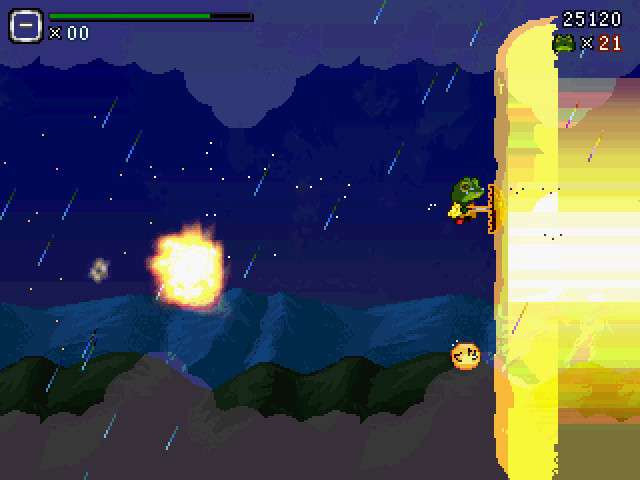
Even though the unblade’s mechanics are fun to use on their own, Unblade frequently invents new ways for you to use these skills. Stage 3 starts with a long descent down a pit filled with instant-kill spikes, it continues on to a segment with mines placed on destructible platforms over lava to prevent you from safely detonating them with the unblade, and later still there is a large, maze-like room which you can navigate in multiple ways. The unblade comes into play to aid in all sorts of strange situations, like guarding against a giant laser while missiles are shot at you from behind or repelling attacks back at a flying miniboss. You can also perform more advanced maneuvers, such as starting a jump across a pit without the unblade deployed, stabbing it upward to defeat an aerial enemy, and holding down the attack button to turn the sword into an umbrella in one fluid motion to safely make your way across the gap. Yes, all of your options ultimately boil down to stabbing, gliding, or blocking, but the unblade is able to interact with virtually everything so figuring out the full extent of what you’re capable of is part of Unblade‘s appeal.
Inui has a few more abilities and tools at his disposal aside from the unblade. To begin with, he can duck, which is occasionally useful for avoiding attacks, though this doesn’t come into play often. A far more handy ability is his downward smash, which immediately sends him down in a straight line if he’s in the air. Aside from breaking certain types of blocks, this smash is useful because it completely cancels his forward momentum; Inui is fairly slippery when he’s not gliding and landing with precision is very difficult unless you use this skill. Aside from his basic abilities, Inui can also find subitems and this is where things really get interesting.
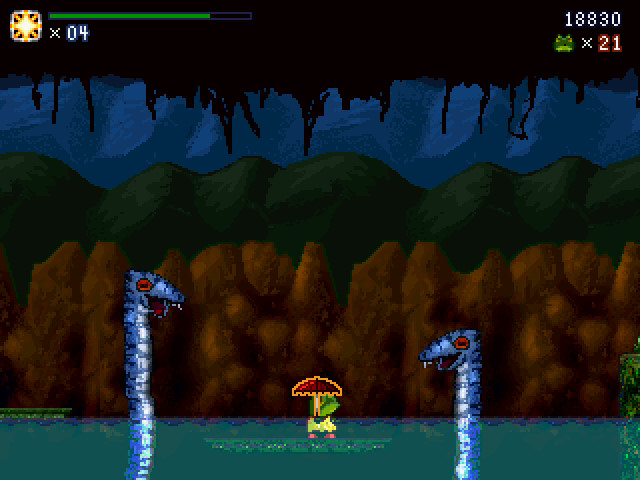
You can only have one type of subitem at a time, but their boxes are everyone. Some of these boxes have a random item while others always have the same item, usually when it is required for an optional collectible. There are eight types of subitems; subitems are consumable and stronger ones come in smaller quantities. Of these eight, four of them are straightforward. There’s a spark which grants you temporary invincibility, a green subitem which creates a healing aura on the ground a few seconds after you set it down, a yellow subitem which travels along the ground, and a bomb which creates a large explosion that can also harm you if you’re not careful.
The other four subitems have a lot more in the way of flexibility. The red subitem is placed on the ground like a mine and explodes after a few seconds or if Inui, the unblade, or an enemy touches it. It is mostly used for destroying certain walls so it’s the most common subitem in the boxes with fixed content, though you can also use it to get invincibility frames since the explosion doesn’t hurt too much. The purple subitem flies into the air, making it effective against flying enemies and several of the bosses, but you can also catch it with your umbrella for a huge vertical boost. As for the blue subitem, you put it on the floor and it bounces you away when you touch it. Blue is a bit easier to use for utility purposes than purple and more flexible in terms of the angle you can aim yourself in.
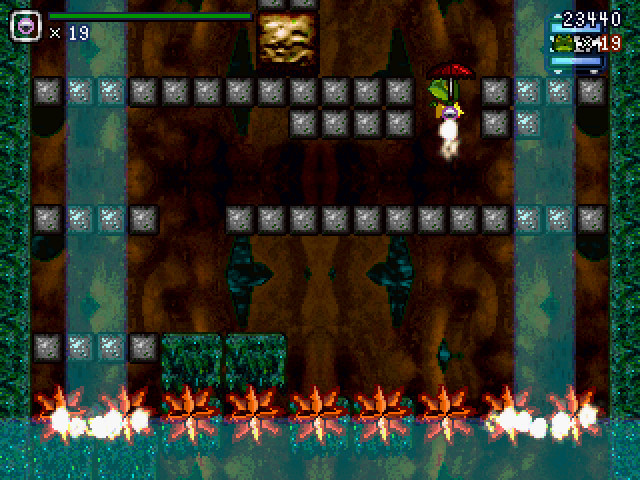
Last of all, a fruit subitem is the strangest and most flexible of them all. This fruit is normally placed on the ground and will release a cloud that stuns enemies when they step on it. However, you can manually release the cloud by touching the fruit with the opened unblade and you can send the cloud flying much farther away if you stomp on it. Aside from subitems, boxes can also contain healing potions and a passive item which doubles your current subweapon’s quantity above the normal maximum. Like with the unblade itself, finding creative uses for all these subitems is part of the fun.
Unblade is a short game and that’s not at all a bad thing. Aside from the tutorial area, there are only seven stages, none of which are particularly long; as of the time I’m writing this article my completion time on the longest stage is 365 seconds and most of the others fall somewhere around the 200 mark. This game doesn’t waste your time. Every area is distinctive and stages constantly change things up as they go on. One moment you’ll be dodging missiles on a collapsing bridge and the next you’ll be riding a tank down a slope. Enemy variety is somewhat low, you see many of the normal enemies the game has to offer by the end of the first stage, but this is fine because the situations in which you confront these enemies can vary so substantially.
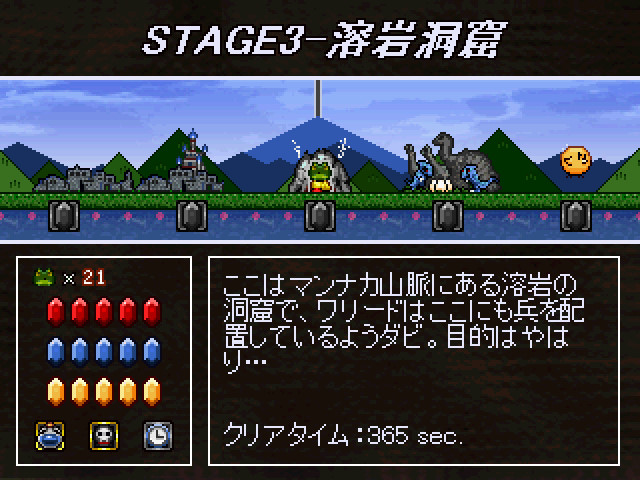
In terms of difficulty, Unblade is mostly on the easy side, though it’s still challenging enough to be satisfying. Even though the stages are short, every screen transition is a checkpoint so you never need to redo challenges you’ve already completed within a single attempt at a stage. Your lives are filled up to full every time you go back to the stage select screen and your maximum life count itself increases constantly. Completing a stage gives you an extra max life, picking up optional collectibles seems to increase it, and sometimes it feels like it goes up for no real reason at all – running out of lives becomes virtually impossible very quickly. Most of the bosses look cool and put up a decent challenge, though the third boss, a lava shark, is boring because you need to wait for it to jump out of the lava. The difficulty curve is excellent as each stage feels more difficult and complex than the stage which came before it without any major difficulty spikes. The one exception is a short optional area you need to go through to get the true ending as it is a massive jump up from everything else in the game (including the final boss) and in a way which just feels frustrating.
Collectible crystals give the stages some added replay value. There are 15 crystals in all split between red, yellow, and blue. Technically, red crystals boost your attack, yellow boost your defense, and blue increase your maximum subitem quantities. That said, the boosts from red and yellow are so minimal that I didn’t notice red’s until I had all five and I had to translate part of the manual to figure out what yellow was doing. These passive benefits being somewhat insubstantial is probably for the best as they would completely trivialize the game otherwise.
Even if you don’t need their benefits, collecting the crystals adds an extra layer of challenge to the game that I really enjoyed. Crystals are often placed in locations which are difficult to reach and require you to think outside of the box to reach them; I only discovered certain ways of using the unblade and the subitems after trying to reach some of the crystals. The number of crystals in each stage varies, but you gain the ability to see which stages still have crystals after beating the game. Crystals may not add much on their own, but the journey to get these items is fantastic.
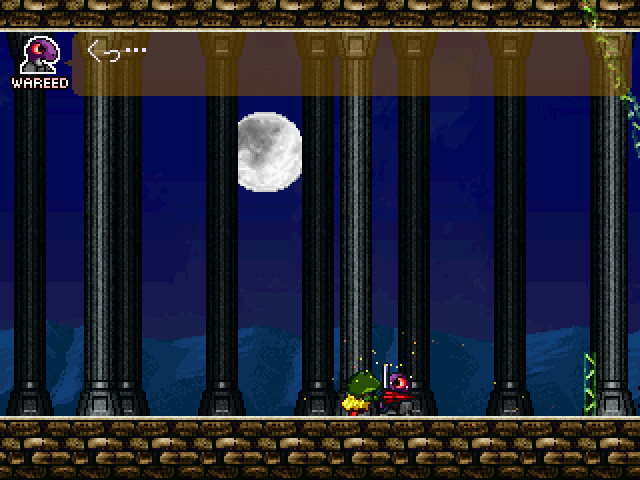
Aesthetically, Unblade is rather good, especially for an older freeware game. The bombastic soundtrack in particular holds up well, which isn’t surprising since multiple people worked on it, including the creator of GIGADEEP. Character sprites also look great and even normal enemies have a surprising amount of personality crammed into a relatively low amount of animation frames. Graphics do falter a bit when it comes to environments as some of the ground textures and background objects, especially in Stage 4, look muddy compared to the clean character sprites. Each stage also ends with a cutscene; there’s a fair amount of written dialogue in these cutscenes and, other than character names, it’s all in Japanese so I can’t read any of it. Thankfully, the basic story is easy to understand (an evil reptilian army is invading a country and a princess gets kidnapped at one point) and characters definitely don’t just stand around during cutscenes either so you can follow the flow of the plot even if you can’t read the dialogue.
Unblade is a great little action platformer and definitely worth your time. It has a few bumps and shows its age in places, such as with the lack of an Options menu, but it’s also rather creative and varied and it’s clear that a lot of work and love went into making it. This is a stylish game with lots of surprises, great pacing, and an awesome weapon.